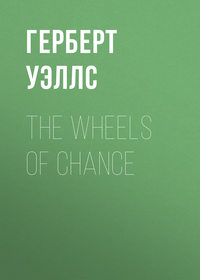 полная версия
полная версияAnticipations
It must always be remembered that at the worst the defeat of such a great organization as the railway system does not involve its disappearance until a long period has elapsed. It means at first no more than a period of modification and differentiation. Before extinction can happen a certain amount of wealth in railway property must absolutely disappear. Though under the stress of successful competition the capital value of the railways may conceivably fall, and continue to fall, towards the marine store prices, fares and freights pursue the sweated working expenses to the vanishing point, and the land occupied sink to the level of not very eligible building sites: yet the railways will, nevertheless, continue in operation until these downward limits are positively attained.
An imagination prone to the picturesque insists at this stage upon a vision of the latter days of one of the less happily situated lines. Along a weedy embankment there pants and clangs a patched and tarnished engine, its paint blistered, its parts leprously dull. It is driven by an aged and sweated driver, and the burning garbage of its furnace distils a choking reek into the air. A huge train of urban dust trucks bangs and clatters behind it, en route to that sequestered dumping ground where rubbish is burnt to some industrial end. But that is a lapse into the merely just possible, and at most a local tragedy. Almost certainly the existing lines of railway will develop and differentiate, some in one direction and some in another, according to the nature of the pressure upon them. Almost all will probably be still in existence and in divers ways busy, spite of the swarming new highways I have ventured to foreshadow, a hundred years from now.
In fact, we have to contemplate, not so much a supersession of the railways as a modification and specialization of them in various directions, and the enormous development beside them of competing and supplementary methods. And step by step with these developments will come a very considerable acceleration of the ferry traffic of the narrow seas through such improvements as the introduction of turbine engines. So far as the high road and the longer journeys go this is the extent of our prophecy.10
But in the discussion of all questions of land locomotion one must come at last to the knots of the network, to the central portions of the towns, the dense, vast towns of our time, with their high ground values and their narrow, already almost impassable, streets. I hope at a later stage to give some reasons for anticipating that the centripetal pressure of the congested towns of our epoch may ultimately be very greatly relieved, but for the next few decades at least the usage of existing conditions will prevail, and in every town there is a certain nucleus of offices, hotels, and shops upon which the centrifugal forces I anticipate will certainly not operate. At present the streets of many larger towns, and especially of such old-established towns as London, whose central portions have the narrowest arteries, present a quite unprecedented state of congestion. When the Green of some future History of the English People comes to review our times, he will, from his standpoint of comfort and convenience, find the present streets of London quite or even more incredibly unpleasant than are the filthy kennels, the mudholes and darkness of the streets of the seventeenth century to our enlightened minds. He will echo our question, "Why did people stand it?" He will be struck first of all by the omnipresence of mud, filthy mud, churned up by hoofs and wheels under the inclement skies, and perpetually defiled and added to by innumerable horses. Imagine his description of a young lady crossing the road at the Marble Arch in London, on a wet November afternoon, "breathless, foul-footed, splashed by a passing hansom from head to foot, happy that she has reached the further pavement alive at the mere cost of her ruined clothes."… "Just where the bicycle might have served its most useful purpose," he will write, "in affording a healthy daily ride to the innumerable clerks and such-like sedentary toilers of the central region, it was rendered impossible by the danger of side-slip in this vast ferocious traffic." And, indeed, to my mind at least, this last is the crowning absurdity of the present state of affairs, that the clerk and the shop hand, classes of people positively starved of exercise, should be obliged to spend yearly the price of a bicycle upon a season-ticket, because of the quite unendurable inconvenience and danger of urban cycling.
Now, in what direction will matters move? The first and most obvious thing to do, the thing that in many cases is being attempted and in a futile, insufficient way getting itself done, the thing that I do not for one moment regard as the final remedy, is the remedy of the architect and builder – profitable enough to them, anyhow – to widen the streets and to cut "new arteries." Now, every new artery means a series of new whirlpools of traffic, such as the pensive Londoner may study for himself at the intersection of Shaftesbury Avenue with Oxford Street, and unless colossal – or inconveniently steep – crossing-bridges are made, the wider the affluent arteries the more terrible the battle of the traffic. Imagine Regent's Circus on the scale of the Place de la Concorde. And there is the value of the ground to consider; with every increment of width the value of the dwindling remainder in the meshes of the network of roads will rise, until to pave the widened streets with gold will be a mere trifling addition to the cost of their "improvement."
There is, however, quite another direction in which the congestion may find relief, and that is in the "regulation" of the traffic. This has already begun in London in an attack on the crawling cab and in the new bye-laws of the London County Council, whereby certain specified forms of heavy traffic are prohibited the use of the streets between ten and seven. These things may be the first beginning of a process of restriction that may go far. Many people living at the present time, who have grown up amidst the exceptional and possibly very transient characteristics of this time, will be disposed to regard the traffic in the streets of our great cities as a part of the natural order of things, and as unavoidable as the throng upon the pavement. But indeed the presence of all the chief constituents of this vehicular torrent – the cabs and hansoms, the vans, the omnibuses – everything, indeed, except the few private carriages – are as novel, as distinctively things of the nineteenth century, as the railway train and the needle telegraph. The streets of the great towns of antiquity, the streets of the great towns of the East, the streets of all the mediæval towns, were not intended for any sort of wheeled traffic at all – were designed primarily and chiefly for pedestrians. So it would be, I suppose, in any one's ideal city. Surely Town, in theory at least, is a place one walks about as one walks about a house and garden, dressed with a certain ceremonious elaboration, safe from mud and the hardship and defilement of foul weather, buying, meeting, dining, studying, carousing, seeing the play. It is the growth in size of the city that has necessitated the growth of this coarser traffic that has made "Town" at last so utterly detestable.
But if one reflects, it becomes clear that, save for the vans of goods, this moving tide of wheeled masses is still essentially a stream of urban pedestrians, pedestrians who, by reason of the distances they have to go, have had to jump on 'buses and take cabs – in a word, to bring in the high road to their aid. And the vehicular traffic of the street is essentially the high road traffic very roughly adapted to the new needs. The cab is a simple development of the carriage, the omnibus of the coach, and the supplementary traffic of the underground and electric railways is a by no means brilliantly imagined adaptation of the long-route railway. These are all still new things, experimental to the highest degree, changing and bound to change much more, in the period of specialization that is now beginning.
Now, the first most probable development is a change in the omnibus and the omnibus railway. A point quite as important with these means of transit as actual speed of movement is frequency: time is wasted abundantly and most vexatiously at present in waiting and in accommodating one's arrangements to infrequent times of call and departure. The more frequent a local service, the more it comes to be relied upon. Another point – and one in which the omnibus has a great advantage over the railway – is that it should be possible to get on and off at any point, or at as many points on the route as possible. But this means a high proportion of stoppages, and this is destructive to speed. There is, however, one conceivable means of transit that is not simply frequent but continuous, that may be joined or left at any point without a stoppage, that could be adapted to many existing streets at the level or quite easily sunken in tunnels, or elevated above the street level,11 and that means of transit is the moving platform, whose possibilities have been exhibited to all the world in a sort of mean caricature at the Paris Exhibition. Let us imagine the inner circle of the district railway adapted to this conception. I will presume that the Parisian "rolling platform" is familiar to the reader. The district railway tunnel is, I imagine, about twenty-four feet wide. If we suppose the space given to six platforms of three feet wide and one (the most rapid) of six feet, and if we suppose each platform to be going four miles an hour faster than its slower fellow (a velocity the Paris experiment has shown to be perfectly comfortable and safe), we should have the upper platform running round the circle at a pace of twenty-eight miles an hour. If, further, we adopt an ingenious suggestion of Professor Perry's, and imagine the descent to the line made down a very slowly rotating staircase at the centre of a big rotating wheel-shaped platform, against a portion of whose rim the slowest platform runs in a curve, one could very easily add a speed of six or eight miles an hour more, and to that the man in a hurry would be able to add his own four miles an hour by walking in the direction of motion. If the reader is a traveller, and if he will imagine that black and sulphurous tunnel, swept and garnished, lit and sweet, with a train much faster than the existing underground trains perpetually ready to go off with him and never crowded – if he will further imagine this train a platform set with comfortable seats and neat bookstalls and so forth, he will get an inkling in just one detail of what he perhaps misses by living now instead of thirty or forty years ahead.
I have supposed the replacement to occur in the case of the London Inner Circle Railway, because there the necessary tunnel already exists to help the imagination of the English reader, but that the specific replacement will occur is rendered improbable by the fact that the circle is for much of its circumference entangled with other lines of communication – the North-Western Railway, for example. As a matter of fact, as the American reader at least will promptly see, the much more practicable thing is that upper footpath, with these moving platforms beside it, running out over the street after the manner of the viaduct of an elevated railroad. But in some cases, at any rate, the demonstrated cheapness and practicability of tunnels at a considerable depth will come into play.
Will this diversion of the vast omnibus traffic of to-day into the air and underground, together with the segregation of van traffic to specific routes and times, be the only change in the streets of the new century? It may be a shock, perhaps, to some minds, but I must confess I do not see what is to prevent the process of elimination that is beginning now with the heavy vans spreading until it covers all horse traffic, and with the disappearance of horse hoofs and the necessary filth of horses, the road surface may be made a very different thing from what it is at present, better drained and admirably adapted for the soft-tired hackney vehicles and the torrent of cyclists. Moreover, there will be little to prevent a widening of the existing side walks, and the protection of the passengers from rain and hot sun by awnings, or such arcades as distinguish Turin, or Sir F. Bramwell's upper footpaths on the model of the Chester rows. Moreover, there is no reason but the existing filth why the roadways should not have translucent velaria to pull over in bright sunshine and wet weather. It would probably need less labour to manipulate such contrivances than is required at present for the constant conflict with slush and dust. Now, of course, we tolerate the rain, because it facilitates a sort of cleaning process…
Enough of this present speculation. I have indicated now the general lines of the roads and streets and ways and underways of the Twentieth Century. But at present they stand vacant in our prophecy, not only awaiting the human interests – the characters and occupations, and clothing of the throng of our children and our children's children that flows along them, but also the decorations our children's children's taste will dictate, the advertisements their eyes will tolerate, the shops in which they will buy. To all that we shall finally come, and even in the next chapter I hope it will be made more evident how conveniently these later and more intimate matters follow, instead of preceding, these present mechanical considerations. And of the beliefs and hopes, the thought and language, the further prospects of this multitude as yet unborn – of these things also we shall make at last certain hazardous guesses. But at first I would submit to those who may find the "machinery in motion" excessive in this chapter, we must have the background and fittings – the scene before the play.12
II
The Probable Diffusion of Great Cities
Now, the velocity at which a man and his belongings may pass about the earth is in itself a very trivial matter indeed, but it involves certain other matters not at all trivial, standing, indeed, in an almost fundamental relation to human society. It will be the business of this chapter to discuss the relation between the social order and the available means of transit, and to attempt to deduce from the principles elucidated the coming phases in that extraordinary expansion, shifting and internal redistribution of population that has been so conspicuous during the last hundred years.
Let us consider the broad features of the redistribution of the population that has characterized the nineteenth century. It may be summarized as an unusual growth of great cities and a slight tendency to depopulation in the country. The growth of the great cities is the essential phenomenon. These aggregates having populations of from eight hundred thousand upward to four and five millions, are certainly, so far as the world outside the limits of the Chinese empire goes, entirely an unprecedented thing. Never before, outside the valleys of the three great Chinese rivers, has any city – with the exception of Rome and perhaps (but very doubtfully) of Babylon – certainly had more than a million inhabitants, and it is at least permissible to doubt whether the population of Rome, in spite of its exacting a tribute of sea-borne food from the whole of the Mediterranean basin, exceeded a million for any great length of time.13 But there are now ten town aggregates having a population of over a million, nearly twenty that bid fair to reach that limit in the next decade, and a great number at or approaching a quarter of a million. We call these towns and cities, but, indeed, they are of a different order of things to the towns and cities of the eighteenth-century world.
Concurrently with the aggregation of people about this new sort of centre, there has been, it is alleged, a depletion of the country villages and small townships. But, so far as the counting of heads goes, this depletion is not nearly so marked as the growth of the great towns. Relatively, however, it is striking enough.
Now, is this growth of large towns really, as one may allege, a result of the development of railways in the world, or is it simply a change in human circumstances that happens to have arisen at the same time? It needs only a very general review of the conditions of the distribution of population to realize that the former is probably the true answer.
It will be convenient to make the issue part of a more general proposition, namely, that the general distribution of population in a country must always be directly dependent on transport facilities. To illustrate this point roughly we may build up an imaginary simple community by considering its needs. Over an arable country-side, for example, inhabited by a people who had attained to a level of agricultural civilization in which war was no longer constantly imminent, the population would be diffused primarily by families and groups in farmsteads. It might, if it were a very simple population, be almost all so distributed. But even the simplest agriculturists find a certain convenience in trade. Certain definite points would be convenient for such local trade and intercourse as the people found desirable, and here it is that there would arise the germ of a town. At first it might be no more than an appointed meeting place, a market square, but an inn and a blacksmith would inevitably follow, an altar, perhaps, and, if these people had writing, even some sort of school. It would have to be where water was found, and it would have to be generally convenient of access to its attendant farmers.
Now, if this meeting place was more than a certain distance from any particular farm, it would be inconvenient for that farmer to get himself and his produce there and back, and to do his business in a comfortable daylight. He would not be able to come and, instead, he would either have to go to some other nearer centre to trade and gossip with his neighbours or, failing this, not go at all. Evidently, then, there would be a maximum distance between such places. This distance in England, where traffic has been mainly horse traffic for many centuries, seems to have worked out, according to the gradients and so forth, at from eight to fifteen miles, and at such distances do we find the country towns, while the horseless man, the serf, and the labourer and labouring wench have marked their narrow limits in the distribution of the intervening villages. If by chance these gathering places have arisen at points much closer than this maximum, they have come into competition, and one has finally got the better of the other, so that in England the distribution is often singularly uniform. Agricultural districts have their towns at about eight miles, and where grazing takes the place of the plough, the town distances increase to fifteen.14 And so it is, entirely as a multiple of horse and foot strides, that all the villages and towns of the world's country-side have been plotted out.15
A third, and almost final, factor determining town distribution in a world without railways, would be the seaport and the navigable river. Ports would grow into dimensions dependent on the population of the conveniently accessible coasts (or river-banks), and on the quality and quantity of their products, and near these ports, as the conveniences of civilization increased, would appear handicraft towns – the largest possible towns of a foot-and-horse civilization – with industries of such a nature as the produce of their coasts required.
It was always in connection with a port or navigable river that the greater towns of the pre-railway periods arose, a day's journey away from the coast when sea attack was probable, and shifting to the coast itself when that ceased to threaten. Such sea-trading handicraft towns as Bruges, Venice, Corinth, or London were the largest towns of the vanishing order of things. Very rarely, except in China, did they clamber above a quarter of a million inhabitants, even though to some of them there was presently added court and camp. In China, however, a gigantic river and canal system, laced across plains of extraordinary fertility, has permitted the growth of several city aggregates with populations exceeding a million, and in the case of the Hankow trinity of cities exceeding five million people.
In all these cases the position and the population limit was entirely determined by the accessibility of the town and the area it could dominate for the purposes of trade. And not only were the commercial or natural towns so determined, but the political centres were also finally chosen for strategic considerations, in a word – communications. And now, perhaps, the real significance of the previous paper, in which sea velocities of fifty miles an hour, and land travel at the rate of a hundred, and even cab and omnibus journeys of thirty or forty miles, were shown to be possible, becomes more apparent.
At the first sight it might appear as though the result of the new developments was simply to increase the number of giant cities in the world by rendering them possible in regions where they had hitherto been impossible – concentrating the trade of vast areas in a manner that had hitherto been entirely characteristic of navigable waters. It might seem as though the state of affairs in China, in which population has been concentrated about densely-congested "million-cities," with pauper masses, public charities, and a crowded struggle for existence, for many hundreds of years, was merely to be extended over the whole world. We have heard so much of the "problem of our great cities"; we have the impressive statistics of their growth; the belief in the inevitableness of yet denser and more multitudinous agglomerations in the future is so widely diffused, that at first sight it will be thought that no other motive than a wish to startle can dictate the proposition that not only will many of these railway-begotten "giant cities" reach their maximum in the commencing century, but that in all probability they, and not only they, but their water-born prototypes in the East also, are destined to such a process of dissection and diffusion as to amount almost to obliteration, so far, at least, as the blot on the map goes, within a measurable further space of years.
In advancing this proposition, the present writer is disagreeably aware that in this matter he has expressed views entirely opposed to those he now propounds; and in setting forth the following body of considerations he tells the story of his own disillusionment. At the outset he took for granted – and, very naturally, he wishes to imagine that a great number of other people do also take for granted – that the future of London, for example, is largely to be got as the answer to a sort of rule-of-three sum. If in one hundred years the population of London has been multiplied by seven, then in two hundred years – ! And one proceeds to pack the answer in gigantic tenement houses, looming upon colossal roofed streets, provide it with moving ways (the only available transit appliances suited to such dense multitudes), and develop its manners and morals in accordance with the laws that will always prevail amidst over-crowded humanity so long as humanity endures. The picture of this swarming concentrated humanity has some effective possibilities, but, unhappily, if, instead of that obvious rule-of-three sum, one resorts to an analysis of operating causes, its plausibility crumbles away, and it gives place to an altogether different forecast – a forecast, indeed, that is in almost violent contrast to the first anticipation. It is much more probable that these coming cities will not be, in the old sense, cities at all; they will present a new and entirely different phase of human distribution.
The determining factor in the appearance of great cities in the past, and, indeed, up to the present day, has been the meeting of two or more transit lines, the confluence of two or more streams of trade, and easy communication. The final limit to the size and importance of the great city has been the commercial "sphere of influence" commanded by that city, the capacity of the alluvial basin of its commerce, so to speak, the volume of its river of trade. About the meeting point so determined the population so determined has grouped itself – and this is the point I overlooked in those previous vaticinations – in accordance with laws that are also considerations of transit.











